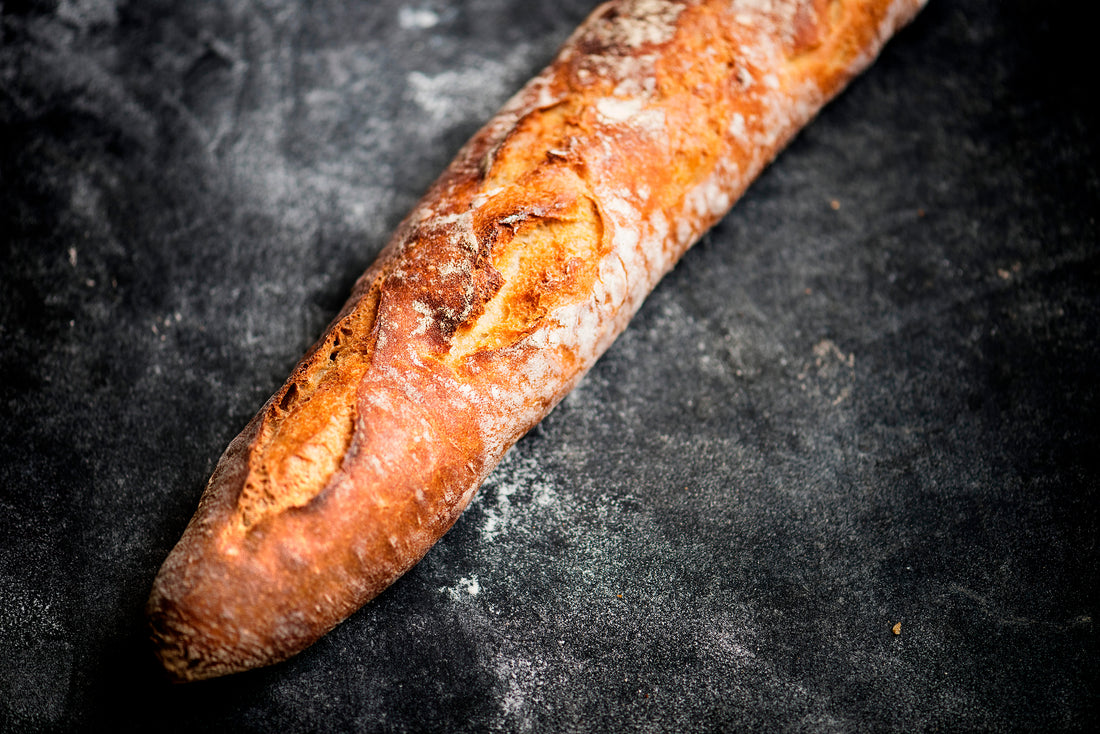1 To make the pre-ferment, in a large mixing bowl, dissolve or break up the sourdough starter in the warm water. Add the flour and mix together to form a paste consistency. Cover with a small mixing bowl and leave to ferment at room temperature for 8 hours or overnight.
2 Put the flour and the salt in a small mixing bowl and set aside. This is the dry mixture.
3 The next day (or after 8 hours), uncover the pre-ferment, which should be bubbling and have a pleasant smell. If it is not bubbling, place in a warm place until it starts to bubble.
4 When the pre-ferment is bubbling, add the warm water, loosen the mixture from the bowl and add the dry mixture. Mix until it all comes together and there are no dry bits at the bottom of the bowl. At this point the dough should be slightly sticky.
5 Cover the mixture with the small mixing bowl and leave to stand for 10 minutes.
6 Knead the mixture 10 times.
7 Turn the dough over in the bowl and make a finger mark in the dough.
8 Cover with the small mixing bowl and leave the dough to rest for 10 minutes.
9 Repeat steps 6-8 another 3 times, making sure the mixture is covered between kneads and remembering to mark the dough to indicate the number of kneads done. If the dough starts to resist and starts to tear, apply less pressure as you knead. If the dough becomes difficult to knead after kneading it 8 times, stop.
10 Cover the dough and leave it to rise for 1 hour.
11 After 1 hour, lightly sprinkle some white flour on a work surface and place the dough onto it.
12 Use a metal dough scraper to cut the dough into 3 pieces.
13 Gently flatten each piece of dough into an oval. Pull both ends of the oval out, then fold them over into the middle. You will now have a roughly rectangular shape.
14 Pull and fold the top of the rectangle one-third of the way towards the middle, pressing it into the dough. Swivel it 180° and repeat. Repeat until you have a neat, long loaf shape. Repeat with the remaining portions of dough.
15 Cover the loaves (seam-side down) and let rest for 15 minutes.
16 Turn one loaf over and flatten slightly. Fold the top right of the rectangle one-third of the way towards the middle, pressing it into the dough. Repeat with the top left and repeat until rolled up. Repeat with the remaining portions of dough.
17 Roll the dough between your hands until you get a baguette about the length of your baking sheet or the desired length. Repeat with the remaining portions of dough.
18 Dust the proofing linen or clean tea/dish towel with flour and lay it on the baking sheet. Arrange the baguettes on the cloth, seam-side up, pulling a bit of excess cloth between each baguette to separate them.
19 Cover with a cloth and allow to proof for 30-60 minutes or until they have nearly doubled in volume.
20 Place the baguettes in the fridge for 30 minutes.
21 Preheat the oven to 250°C (500°F) Gas and place a deep roasting tray at the bottom of the oven and a baking sheet on the middle shelf.
22 Remove the baguettes from the fridge and turn the baguettes over, seam-side down. Dust the baguettes with flour.
23 Slash the baguettes with a sharp serrated knife or a lamé to create a pattern of your choice.
24 Slide the baguettes onto the preheated baking sheet in the oven and pour a cup of water into the hot roasting tray.
25 Bake for 15-25 minutes until golden brown. To check if baked through, tip one loaf upside down and tap the bottom it should sound hollow. Set on a wire rack to cool it.
Ingredients
300 g/2¼ cups plain/all-purpose flour, plus extra for dusting
9 g/2 teaspoons salt
150 g/150 ml/⅔ cup warm water
For the pre-ferment
10 g/⅓ oz. sourdough starter
125 g/125 ml/½ cup warm water
125 g/1 scant cup white
strong bread flour
Equipment
tea/dish towel
Makes 3 baguettes

Leave a comment